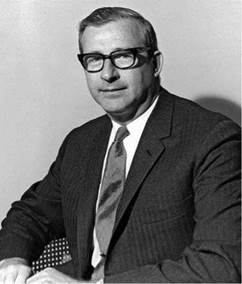Enter Tom Paine
Even before going to the White House press room after his meeting with Johnson, James Webb had made a quick call to NASA Deputy Administrator Thomas O. Paine, telling Paine that his resignation was about to be announced and that the president wanted Paine to serve as acting NASA administrator. This shift in command marked a new era for NASA; Tom Paine had a markedly different personality than James Webb. Where Webb was a consummate Washington insider, skilled in forging political coalitions in support of NASA’s programs but careful not to get out in front of what in his judgment was politically acceptable, Paine was a Washington outsider, naive in political dealings, ebullient, and a technological visionary. He had been a submarine officer during World War II and had a fascination with all things naval. Paine had a doctorate in physical metallurgy from Stanford and had spent his whole professional career with General Electric. Since 1963 he had been the manager of the General Electric “think tank” called TEMPO; there he was exposed to a wide variety of innovative technological ideas in both the civilian and national security sectors. He had had no particular exposure to the space program prior to coming to NASA. Paine had decided that some Washington experience would be good for his career and had put his name on file with the Civil Service Commission as a person interested in a high-level government position; it was there that NASA found him in January 1968 as it searched for a replacement for Deputy Administrator Robert Seamans.10
In his early months as NASA deputy administrator Paine told senior NASA managers that he saw the position of the United States in space “as somewhat analogous to that of the Atlantic Coast of Europe in the 15th century. We have small ships and crude but usable navigational systems and life-support techniques.” The question for the future, he thought, was “how should we structure our efforts to build navigation capability and conduct exploration?” Paine saw NASA as analogous to the Portuguese “Research Institute for Navigation” that had been established in 1418 by Prince Henry
|
Thomas O. Paine, NASA Acting Administrator and Administrator, 1968-1970. (NASA photograph) |
the Navigator. That “maritime NASA” was “probably as significant as the later dramatic and successful Portuguese voyages of discovery,” Paine suggested, because “it provided a central focus for the best European cartographers, astronomers, navigators, shipwrights, riggers, gunners, coopers, and other medieval scientists, technologists, and skilled workers.” This emphasis on maritime technology, he noted, was “the base on which the Spanish and later the British, French, and Dutch empires were founded, spreading European seacoast culture, technology, and languages around the world.” Paine wondered whether the United States could have “an analogous opportunity in space.”11 It would have been hard to conceive of Jim Webb pursuing this line of thought.
As Paine took over the direction of the space agency in October 1968, he urged people at NASA to be bolder in their thinking than they had been while Webb was administrator. New in Washington, believing strongly in the historical importance of the space program, and optimistic that he could convince others of that importance, Paine faced the incoming Nixon administration with anticipation, telling a reporter soon after the presidential election that he would present the new president “with an ambitious agenda for future man-in-space flights.”12











